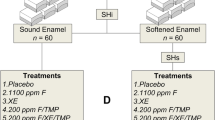Abstract
AIM: This study aimed to investigate the in vitro effects of three paediatric liquid oral medicines on bovine dental enamel subsurfaces under pH cycling conditions. METHODS: Bovine enamel blocks were evaluated for surface hardness at baseline for sample selection. 52 intact bovine enamel blocks (16mm2) were randomly divided into four groups (n=13) according to the immersion treatments: G1: antibiotic (Klaricid®), G2: antihistamine (Claritin®), G3: antihistamine (Dimetapp®) and G4: control (de-ionised water). The blocks were submitted to pH cycling treatments twice a day for 12 days. The medicines were evaluated for pH, viscosity, and concentration of calcium, phosphate and fluoride. After the treatment period, cross-sectional microhardness (CSMH) measurements of the enamel blocks were taken and the data, expressed in Knoop hardness number (kg/mm2) was used to calculate the ΔS. STATISTICS: ANOVA followed by the Tukey test were used for statistical analyses (p<0.05). RESULTS: The antibiotic Klaricid® showed the highest concentration of fluoride, calcium and phosphate. Considering pH and viscosity, the following pattern was observed according to the treatment group: G4>G1>G2>G3 and G1>G2>G3>G4 respectively. Regarding the demineralisation pattern, the following results were observed: G4>G3>G2>G1. Compared to the control, the antibiotic and both the anti-histamines provoked less demineralisation of the enamel blocks (p<0.05). CONCLUSIONS: Antibiotic G1 (Klaricid ®sented an in vitro protective effect against acid attacks probably due to its mineral content and viscosity.
Similar content being viewed by others
References
Argenta RMO, Tabchoury CPM, Cury JA. A modified pH cycling model to evaluate fluoride effect on enamel demineralization. Brazilian Oral Research 2003; 17:241–246.
Bretz WA, do Valle EV, Jacobson JJ et al. Unstimulated salivary flow rates of young children. Oral Surgery, Oral Medicine, Oral Pathology, Oral Radiology, and Endodontics 2001; 91:541–545.
Cairns AM, Watson M, Creanor SL, Foye RH. The pH and titratable acidity of a range of diluting drinks and their potential effect on dental erosion. Journal of Dentistry 2002; 30:313–317.
Ccahuana-Vésquez RA, Cury JA. Streptococcus mutans biofilm model to evaluate antimicrobial substances and enamel demineralization. Brazilian Oral Research 2010; 24:135–141.
Costa CC, Almeida IC, da Costa Filho LC. Erosive effect of an antihistamine-con-taining syrup on primary enamel and its reduction by fluoride dentifrice. International Journal of Paediatric Dentistry 2006; 16:174–180.
Cury JA, Tenuta LM. Enamel remineralization: controlling the caries disease or treating early caries lesions? Brazilian Oral Research 2009; 23 suppl 1:23–30.
da Costa CC, Almeida IC, da Costa-Filho LC, Oshima HM. Morphology evaluation of primary enamel exposed to antihistamine and fluoride dentifrice — an in vitro study. General Dentistry 2006; 54:21–27.
Damato FA, Strang R, Stephen KW. Effect of fluoride concentration on reminer-alization of carious enamel: an in vitro pH-cycling study. Caries Research 1990; 24:174–180.
Featherstone JD, ten Cate JM, Shariati M, Arends J. Comparison of artificial carieslike lesions by quantitative microradiography and microhardness profiles. Caries Research 1983; 17:385–391.
Feigal RJ, Jensen ME, Mensing CA. Dental caries potential of liquid medications. Paediatrics 1981; 68:416–419.
Fiske CM, Subbarow Y The colorimetric determination of phosphorus. Journal of Biological Chemistry 1925; 66:375–400.
Fontana M, Haider A, Gonzéles-Cabezas C. Caries lesion development and biofilm composition responses to varying demineralization times and sucrose exposures. Biofilms 2004; 1:229–237. Hughes JA, West NX, Parker DM, Newcombe RG, Addy M. Development and evaluation of a low erosive blackcurrant juice drink. 3.
Final drink and concentrate, formulae comparisons in situ and overview of the concept. Journal of Dentistry 1999; 27:345–350.
Kielbassa AM, Wrbas KT, Schulte-Mönting J, Hellwig E. Correlation of transversal microradiography and microhardness on in situ-induced demineralization in irradiated and nonirradiated human dental enamel. Archives of Oral Biology 1999; 44:243–251.
Lammers PC, Borggreven JM, Driessens FC. Acid-susceptibility of lesions in bovine enamel after remineralization at different pH values and in the presence of different fluoride concentrations. Journal of Dental Research 1991; 226:19908–19916.
Nekrashevych Y Stösser L. Protective influence of experimentally formed salivary pellicle on enamel erosion. Caries Research 2003; 37:225–231.
Neves BG, Pierro VS, Maia LC. Paediatrician’s perceptions of the use of sweetened medications related to oral health. Journal of Clinical Paediatric Dentistry 2008; 32:133–137.
Neves BG, Farah A, Lucas E, Souza VP, Maia LC. Are paediatric medicines risk factors for dental caries and dental erosion? Community Dental Health 2010; 27:46–51.
Nunn JH, Salina KF, Sharkey I, Coulthard M. The dental implications of chronic use of acid medicines in medically compromised children. Pharmacy World & Science 2011; 23:118–119.
Rekola M. In vivo acid production from medicines in syrup form. Caries Research 1989; 23:412–416.
Roberts IF, Roberts GJ. Relation between medicines sweetened with sucrose and dental disease. British Medical Journal 1979; 2:14–16.
Sag C, Ozden FO, Acikgoz G, Anlar FY The effects of combination treatment with a long-acting beta2-agonist and a corticosteroid on salivary flow rate, secretory immunoglobulin A, and oral health in children and adolescents with moderate asthma: a 1-month, single-blind clinical study. Clinical Therapeutics 2007; 29:2236–2242.
Sahgal J, Sood PB, Raju OS. A comparison of oral hygiene status and dental caries in children on long term liquid oral medications to those not administered with such medications. Journal of Indian Society of Pedodontics and Preventive Dentistry 2002; 20:144–151.
Sousa RP, Zanin ICJ, Lima JPM et al. In situ effects of restorative materials on dental biofilm and enamel demineralization. Journal of Dentistry 2009; 37:44–51.
Valinoti AC, Neves BG, da Silva EM, Maia LC. Surface degradation of composite resins by acidic medicines and pH-cycling. Journal of Applied Oral Science 2008; 16:257–265.
Valinoti AC, da Silva Pierro VS, da Silva EM, Maia LC. In vitro alterations in dental enamel exposed to acids medicines. International Journal of Paediatric Dentistry 2011; 21:141–150.
Author information
Authors and Affiliations
Corresponding author
Rights and permissions
About this article
Cite this article
Soares, D.N., Valinoti, A.C., Pierro, V.S.S. et al. Cross-sectional microhardness of bovine enamel subjected to three paediatric liquid oral medicines: an in vitro study. Eur Arch Paediatr Dent 13, 261–265 (2012). https://doi.org/10.1007/BF03262882
Published:
Issue Date:
DOI: https://doi.org/10.1007/BF03262882




